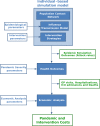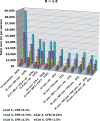Economic analysis of pandemic influenza mitigation strategies for five pandemic severity categories
- PMID: 23496898
- PMCID: PMC3606600
- DOI: 10.1186/1471-2458-13-211
Economic analysis of pandemic influenza mitigation strategies for five pandemic severity categories
Abstract
Background: The threat of emergence of a human-to-human transmissible strain of highly pathogenic influenza A(H5N1) is very real, and is reinforced by recent results showing that genetically modified A(H5N1) may be readily transmitted between ferrets. Public health authorities are hesitant in introducing social distancing interventions due to societal disruption and productivity losses. This study estimates the effectiveness and total cost (from a societal perspective, with a lifespan time horizon) of a comprehensive range of social distancing and antiviral drug strategies, under a range of pandemic severity categories.
Methods: An economic analysis was conducted using a simulation model of a community of ~30,000 in Australia. Data from the 2009 pandemic was used to derive relationships between the Case Fatality Rate (CFR) and hospitalization rates for each of five pandemic severity categories, with CFR ranging from 0.1% to 2.5%.
Results: For a pandemic with basic reproduction number R0 = 1.8, adopting no interventions resulted in total costs ranging from $441 per person for a pandemic at category 1 (CFR 0.1%) to $8,550 per person at category 5 (CFR 2.5%). For severe pandemics of category 3 (CFR 0.75%) and greater, a strategy combining antiviral treatment and prophylaxis, extended school closure and community contact reduction resulted in the lowest total cost of any strategy, costing $1,584 per person at category 5. This strategy was highly effective, reducing the attack rate to 5%. With low severity pandemics costs are dominated by productivity losses due to illness and social distancing interventions, whereas higher severity pandemic costs are dominated by healthcare costs and costs arising from productivity losses due to death.
Conclusions: For pandemics in high severity categories the strategies with the lowest total cost to society involve rigorous, sustained social distancing, which are considered unacceptable for low severity pandemics due to societal disruption and cost.
Figures





References
-
- ANZIC Influenza Investigators. Critical Care Services and 2009 H1N1 influenza in Australia and New Zealand. N Engl J Med. 2009;2009(361):1925–1934. - PubMed
-
- Nicoll A, Coulombier D. Europe’s initial experience with pandemic (H1N1) 2009 - mitigation and delaying policies and practices. Euro Surveill. 2009;14(29):pii=19279. - PubMed
MeSH terms
Substances
LinkOut - more resources
Full Text Sources
Other Literature Sources
Medical

